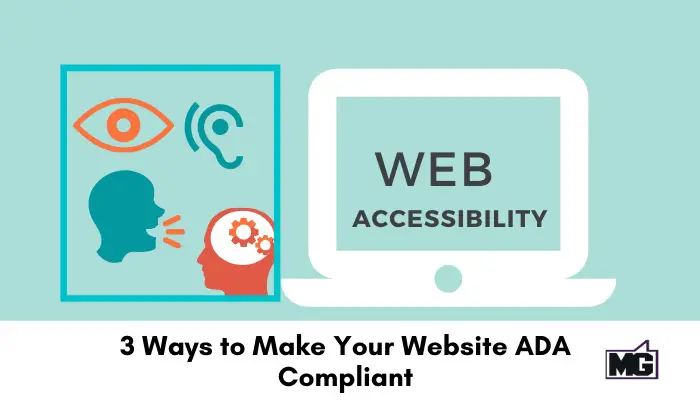
When the Americans with Disabilities Act (ADA) regulations were enacted to protect people with disabilities against discrimination, no accessibility guidelines were developed covering the online space. However, in 2018, this changed as new regulations for web accessibility were introduced. With the goal of facilitating inclusive experiences on the web, the ADA guidelines allow users with disabilities to access and enjoy content on websites.
While there are many benefits to complying with this law, many small businesses find it challenging to meet all the requirements. This can be because of limited financial ability and the highly-dynamic content on their websites. Below are three reasonable ways to make your website ADA compliant.
Use Accessibility Plugins to enforce ADA compliance
There are several WordPress website plugins designed to help web owners with ADA compliance. These plugins scan your website to identify potential accessibility problems, then provide actionable tips to fix the issues. Some of the most helpful accessibility plugins include:
This plugin is regularly updated to meet ADA standards. It addresses compliance challenges within WordPress themes. WP Accessibility allows users to add text direction and language HTML attributes to help with accessibility. It also has a toolbar that toggles between grayscale, large print, and high contrast views. Alt image descriptions are easy to add, and there are many more elements that will help with ADA compliance. It also provides third-party integrations for enhanced functionality and performance.
This unique plugin checks whether a WordPress website complies with ADA guidelines. The plugin is updated when ADA web guidelines are changed. With this plugin, you can schedule a complete website scan. You can also set it to run when you publish new content or make changes to your website. The plugin uncovers ADA compliance issues and recommends possible solutions for you.
The Userway tool is an add-on to your WordPress site. This plugin essentially creates a “new” version of your site when accessed, making the site WCGA 2.0 and ADA compliant. Its main functions include keyboard navigation, highlighting links, and desaturating site colors. Userways’ tools improve the accessibility of a website without interfering with the website’s actual code or structure.
Other common plugins that can help with ADA compliance include:
WP Accessibility Helper
WA11Y Web Accessibility Toolbox
Accessible Widget, Accessibility poetry
WP User Stylesheet Switcher
Be mindful of the content you use
Making your website ADA compliant may involve tweaking your content in several ways. To start with, create a descriptive alt tag for every image that appears on your website. You should also add text transcripts for any audio and video content. This ensures those with disabilities can read or hear the descriptions of content they cannot hear or view.
As a website owner, you should simplify graphical elements on your website and enhance the color contrast. This ensures that those with visual or cognitive impairment can easily read your content. For text, use readable and user-friendly font style, size, and color. Avoid script fonts and white on light colors where possible.
Work on the interface design and layout
A consistent and well-organized layout contributes to making your website ADA compliant. It is best to organize all menus, buttons, and links in a way that easily differentiates them from each other. Additionally, break up large blocks of text so that users can quickly scan through your page content. The goal is to improve the layout of your interface and make it more intuitive. Make sure all users can easily navigate your website, from seniors to those with disabilities.
If there are forms on your website, it is crucial to set them up clearly. Always test forms to check whether labels are clearly identified and that all fields have visual cues indicating where user input is required. The form’s input fields should have attributes so those using screen readers know whether their input was valid or not. Additionally, your website should have a report functionality that lets users know when their submission was successful or not. If there was an error, it should return the user to the invalid field.
Another best practice tip is ensuring that pop-ups or any other auto-play content on your website are easy to close. Ensure this works on both mobile and desktop sites. Otherwise, these could be a nuisance not only to those with disabilities but every user on the web.
Conclusion
Ensuring your website complies with the WCA Guidelines is not just about adhering to the ADA law, but also improving your business. Making a website accessible is a great way of accommodating all users, especially those with special needs and requirements. Furthermore, it enhances the experience of every user, from homebound seniors to visually impaired customers. Not to mention the millions of people who rely on the web for communication, shopping, paying bills, and other personal activities. ADA compliance broadens the scope of users who can comfortably interact with what your website has to offer. By making your website ADA compliant you can expand your brand awareness and customer base.
Looking for help? Tired and believing there has got to be a better way?
Let’s talk about your business. With over a decade of experience leading companies and transforming lives, and a Master’s degree in Org. Development and Leadership, Mike can help you find the best way forward!
Contact Mike today to start the breakthrough!
The post 3 Ways to Make Your Website ADA Compliant appeared first on Mike Gingerich.
Read more: mikegingerich.com










